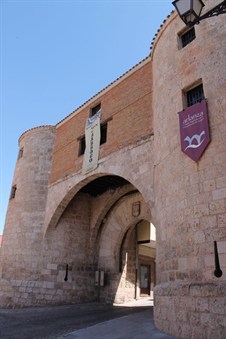Lerma
 The municipality of Lerma is now part of the Autonomous Community of Castilla y León, in the Province of Burgos. The imprint left by the Duke of Lerma and valido of King Philip III is still visible today. Known for being the main example of architecture of Herrera in Spain, Lerma has a Plaza mayor which is one of the largest in the nation, with an extension of almost 7,000 square metres. On it stands the Palacio Ducal, designed by the architect Francisco de Mora (1553-1610) and maintained in excellent condition, although it had been used as a prison during the Civil War. The Arco de la Cárcel (Arch of the Prison, photo) is instead the only gate of the ancient medieval walls which still stands, but has some additions dating from the first decade of the seventeenth century, when the project began to turn it into a prison. Many other buildings in the city, mostly religious, date back to the years of the Duke of Lerma. The Collegiate Church of San Pedro was consecrated in 1617 and it houses many precious objects of Baroque art. The convent of San Blas is another work of Francisco de Mora that housed Dominican nuns, while the convent of Santa Teresa, dating from the same period, was the home of the Carmelite friars for centuries. The convent of the Madre de Dios (Mother of God), located in front of the Puerta de la Cárcel (Gate of the Prison), was personally sponsored by the Duke, while the Monastery of the Ascensión de Nuestro Señor (Ascension of our Lord), or convent of Santa Clara, was founded by the daughter-in-law of the Duke, Mariana de Padilla (the wife of the Duke of Uceda) in which the Infanta Margarita was baptized in 1610. The convent of San Francisco de los Reyes (Saint Francis of the Kings) was instead founded by one of the sisters of the Duke, the Countess of Altamira, doña Leonor de Rojas. It was also celebrated by Lope de Vega in the comedy La burgalesa de Lerma (1613), which evokes the sumptuous feasts celebrated by Philip III and his favourite in the villa. Lerma still pays homage to its illustrious past with the “month of the Baroque”, an initiative of tourist and cultural interest that is celebrated during the month of August.
The municipality of Lerma is now part of the Autonomous Community of Castilla y León, in the Province of Burgos. The imprint left by the Duke of Lerma and valido of King Philip III is still visible today. Known for being the main example of architecture of Herrera in Spain, Lerma has a Plaza mayor which is one of the largest in the nation, with an extension of almost 7,000 square metres. On it stands the Palacio Ducal, designed by the architect Francisco de Mora (1553-1610) and maintained in excellent condition, although it had been used as a prison during the Civil War. The Arco de la Cárcel (Arch of the Prison, photo) is instead the only gate of the ancient medieval walls which still stands, but has some additions dating from the first decade of the seventeenth century, when the project began to turn it into a prison. Many other buildings in the city, mostly religious, date back to the years of the Duke of Lerma. The Collegiate Church of San Pedro was consecrated in 1617 and it houses many precious objects of Baroque art. The convent of San Blas is another work of Francisco de Mora that housed Dominican nuns, while the convent of Santa Teresa, dating from the same period, was the home of the Carmelite friars for centuries. The convent of the Madre de Dios (Mother of God), located in front of the Puerta de la Cárcel (Gate of the Prison), was personally sponsored by the Duke, while the Monastery of the Ascensión de Nuestro Señor (Ascension of our Lord), or convent of Santa Clara, was founded by the daughter-in-law of the Duke, Mariana de Padilla (the wife of the Duke of Uceda) in which the Infanta Margarita was baptized in 1610. The convent of San Francisco de los Reyes (Saint Francis of the Kings) was instead founded by one of the sisters of the Duke, the Countess of Altamira, doña Leonor de Rojas. It was also celebrated by Lope de Vega in the comedy La burgalesa de Lerma (1613), which evokes the sumptuous feasts celebrated by Philip III and his favourite in the villa. Lerma still pays homage to its illustrious past with the “month of the Baroque”, an initiative of tourist and cultural interest that is celebrated during the month of August.
